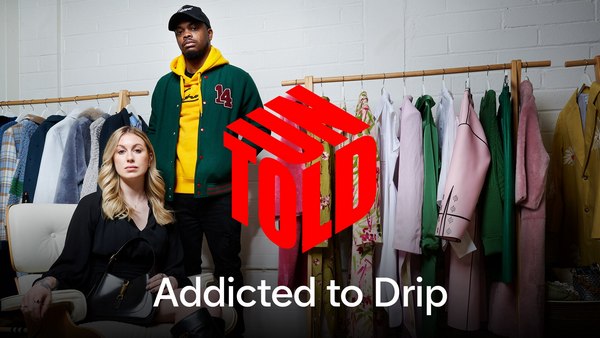Proper Gander – Splashing out on drip
 Wearing designer clothing and flashy accessories to show off wealth is nothing new; it’s the particular styles and favoured brands which come and go, along with the terminology used. The word ‘bling’ became as unfashionable as neon legwarmers once it picked up connotations of tackiness. Since around 2018, ‘drip’ has steadily come into vogue, meaning blatantly fashionable, proven only by owning eye-wateringly expensive clothes, shoes, jewellery or watches of the right brands. The term comes from ‘dripping’ with money, enough to fork out £5,500 on a Chanel bag, for example.
Wearing designer clothing and flashy accessories to show off wealth is nothing new; it’s the particular styles and favoured brands which come and go, along with the terminology used. The word ‘bling’ became as unfashionable as neon legwarmers once it picked up connotations of tackiness. Since around 2018, ‘drip’ has steadily come into vogue, meaning blatantly fashionable, proven only by owning eye-wateringly expensive clothes, shoes, jewellery or watches of the right brands. The term comes from ‘dripping’ with money, enough to fork out £5,500 on a Chanel bag, for example.
Presenter and comedian David Whitely, also known as Sideman, explores the ‘drip’ lifestyle in a documentary shown as part of Channel 4’s Untold strand. Addicted to Drip is aimed at viewers aged 16 to 34, those most likely to be attracted to the trend. The research liberally quoted throughout the show is from a study of 2,000 people in that age range carried out by financial coaching company Claro Wellbeing.
Addicted To Drip follows a usual template for documentaries, starting with a rapid round of clips from the show ahead, patronisingly expecting people not to stay tuned in unless they already know what they’ll be watching. The rest of the programme keeps to the familiar pattern of the presenter meeting people affected, serious points made by experts and occasional bouts of worrying stats. The presenter is expected to go on a personal journey while making a documentary like this, which is just Whitely finding out whether he becomes inclined towards a drip-fed lifestyle and deciding ‘no’.
One of the people Whitely talks with is Samantha, who says she tried ‘to fill some kind of void’ after bereavements with spending sprees on clothes and accessories using her inheritance money. When she reached the point of having thousands of pounds worth of designer gear but not enough funds to buy a train ticket, she came to believe she was wasting money and her life. Others have got into debt in order to buy into drip: one in ten young people are taking out credit at least monthly to fuel their spending on designer brands. Not all of the under-35s surveyed would have heard of the term ‘drip’, but regardless, almost half are in debt from purchasing luxury goods, and almost a third have less than £100 in savings. The kind of pressure this can involve causes problems beyond the fiscal. Although being in debt has been normalised, especially since prices shot up, 58 percent feel stressed about their financial situation. For some, the effects are worse: Whitely meets fashion influencer Michelle, whose mental health declined from trying to live up to the lifestyle to the extent of ending up in hospital.
Whitely also speaks with some of those who have done well for themselves financially through drip. Drew dropped out of studying medicine, realising he could make more money building up his business as an influencer with his own clothing brand. ‘Godfather of Drip’ Chiefer has a well-established and lucrative business selling jewellery to celebs. He says that most people who are into drip weren’t born into wealth, and wear designer clothes now because they weren’t able to have them when they were growing up. Being motivated to have an affluent lifestyle by wanting to escape from past hardship seems to be one of the characteristics of drip.
Drip-friendly brands tend to be pitched at younger people, especially those still living with their parents and who don’t have the financial commitments which come with having children. Once a drip product is launched, much of its promotion is put together and spread by its own customers, which is a capitalist’s dream come true. Those living the drip life market themselves and what they’re wearing through social media, aiming for an image which will be popular enough to bring in enough of an income.
The up-front role of omnipresent smartphones is what makes the drip lifestyle different to previous niche wealth-based groups, such as ‘sloanes’. As Stacey Lowman of Claro Wellbeing tells us, there’s a ‘perfect storm’ of social media, advertising strategies and online banking these days. Technology has been shaped to pair up products with customers, so that their money can easily move, largely upwards, with just a few taps on a screen. Some people have become rich and happy through this, others have suffered both financially and emotionally, as shown on Addicted To Drip.
Wanting to have nice things isn’t the issue in itself; problems lie with what drives this. In capitalism, ‘nice things’ get reduced to a series of wealth-related values. The people interviewed by Whitely may be bashful about how much they’ve spent on togs and trinkets, but the exorbitant prices are themselves a selling point, weirdly. Everything else in the process can also be boiled down to a monetary amount, from whatever wages those who make the commodities receive, to the spending power of customers following a social media influencer, to, ultimately, the amount of profit made by those at the top of the food chain. For them, the money’s coming in more like a flood than a drip.
MIKE FOSTER
Next article: Book reviews – Anderson&Ludenhoff, Rayson, Knott ⮞
